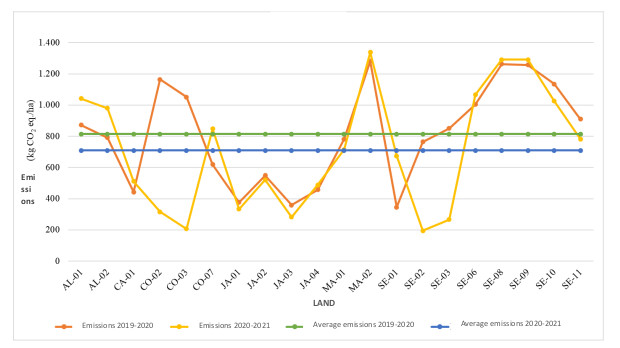RESULTS ACTIONS MONITORING
This activity proposes the study and monitoring over time of C fixation rates in the demonstration farms network on a regional scale. This will make it possible to assess the mitigation capacity of the GAPs proposed by the project, for which soil samples will be taken at different depths to analyse the OM and OC content.
The first results obtained regarding the influence of the management system on C stocks in the soil are presented below:
In this case, differences in soil OC content have been studied for the same agro-climatic sector between crops managed under CA (No-tillage in arable crops and Cover Crops in woody crops) and crops managed with conventional tillage.
To date, in all agro-climatic sectors, higher OC contents have been observed in soils managed under CA techniques. Although in most of them these differences compared to conventionally tilled soils are not statistically significant, in many cases they represent a significant increase in the soil's sink capacity.
An example of this in arable crops, in the case of agroclimatic sector 2, are the farms where the farmer has chosen direct sowing as a management system for his farm, which have up to 40% and 20% more C than soils under conventional tillage for the localities of Villalba del Alcor and Las Cabezas de San Juan respectively.
In woody crops, in all cases, apart from agroclimatic sector 2, farms with vegetation covers have higher surface OC contents. The olive groves with ground cover located in agroclimatic sector 7, whose soils have 35% more CO than those corresponding to olive groves grown under conventional tillage, stand out above all others.
The aim of this action is to analyse the average C contents present in Andalusian agricultural soils and their spatial variability, in order to use this data as a starting point for calculating the region's C storage potential. In this way it will be possible to estimate to what extent the soils of the region can store C with the GAPs proposed by the project.
To date, no results are available.
The objective of this action is to validate, at European level, the effectiveness of the C accounting methodology at regional level and the technological tool, through the verification of C increases in farms network that replicate the GAPs proposed by the project and implemented in similar agro-climatic conditions.
The objective of the action is to assess the GHG emissions of different soil management systems in the farm network. The result is obtained by measuring the energy consumption of crops in the different soil management systems, taking into account all the inputs necessary for the correct implantation of crops.
The monitoring has been carried out on the most representative demonstration farms, the most representative of the crop-management system-machinery trinomial. To date, monitoring has been carried out in two seasons, and it has been verified that, thanks to the application of GAPs, emissions in a single season have been reduced by 12.91%, which means that 105.1 kg CO2 equivalent per hectare per year have been emitted into the atmosphere. In terms of energy use, this represents a reduction of 6.33%. For this calculation, a total of 20 demonstration plots have been considered, including woody and herbaceous crops.

The aim of this action is to validate the environmental benefits of the GAPs implemented within the framework of the project, as well as to verify their agronomic viability, through the monitoring and evaluation of the indicators defined in action A.1. These indicators take values from 0 to 100 depending on the degree of sustainability, where 0 is the least sustainable value and 100 the most sustainable value.
To date, the network of demonstration farms has been monitored on a regional scale throughout the 2019/2020 and 2020/2021 agricultural campaigns, obtaining, in general, that systems based on Conservation Agriculture are, on average, more sustainable than systems based on Conventional Tillage. Furthermore, it has been seen that, regardless of the absolute values, the differences between the two management systems from one season to the next have increased in favour of Conservation Agriculture.




This action aims to check the degree of acceptance of the proposed techniques, of the C calculation methodology implemented in the project, as well as the technological tool developed in the project for mobile devices. In this way, it will be possible to evaluate its application and potential for transfer to a larger scale in the European Mediterranean agriculture, as well as to monitor the feasibility and benefits of the implementation actions in social and economic terms.
To date, no results are available.
The tasks carried out under this action are aimed at the calculation and evaluation of the indicators used in the of LIFE Programme framework, based on the information provided by the indicators of the monitoring actions.
To date, no results are available.
This post is also available in: Español (Spanish)

